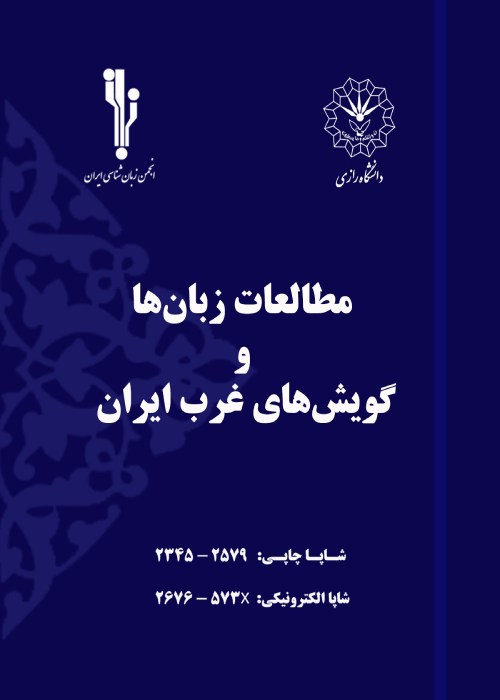Redefinition of Compounding in Sorani Kurdish Morphology: An Investigation on Nominal Compounds in Construction Morphology Approach
Various issues in morphological researches are promising enough for any linguist to devote a large part of his/her professional life to deal with morphological issues like compounding. In fact researches on compounding is at the center of attention among others. The most salient reason behind this is the use of compounding across all the world languages. The other reason is a kind of internal syntax within the resulting lexical items which imply that they are grammatically outlaws but pragmatically acceptable. In what follows we will focus on nominal compounds formation in Sorani Kurdish based on Booij's (2010) Construction Morphology framework. What's interesting most here is presence of Semantic Head which leads to a dichotomy, namely, Exocentrics beside Endocentric compounds. In the second phase there is an emergent requirement to make more detailed classifications. In other words, while the presence of Head is the criterion to classify a nominal compound as endocentric, its position gives rise to the following classes: Head First, Head Last and Dual Head and Sorani Kurdish enjoys all the potential forms mentioned above. A bunch of works conducted to investigate compounding in Sorani Kurdish in different frames are as follow, Abbas (2021), Mostafa (2020), McCarros (2017) and Hamad (2016).
Theoretical Framework:
Epistemologically Construction Morphology grounds in cognitive linguistics with a Word-based view toward complex lexical items. Based on this approach a complex word is a construction, resulted from the integration of allowed items in the language supervised by mental frames lied in Hierarchical Lexicon named schemas. In other word any construction is a systematic integration of form and meaning. For instance, [unhappy]Adj in English observes the word formation pattern with the systematic meaning along with [not having the property of X]Adj in mental lexicon which does have a pyramid like shape with Macro-Schema on top, Second Order-Schema in between and Sub-Schemas in the base. So the schematic representation for the above instantiations and words alike adjectives will be as follow: The present paper tends to find answers for following questions applying the construction morphology theory.What is the Macro-Schema dominating the nominal compounds in Sorani Kurdish?What are the Second-order Schemas governing the nominal compounds in Sorani Kurdish?What are the most frequently used semantic relations in Sorani Kurdish nominal compounds?
At a very initial stage of the research a corpus of 1400 nominal compounds extracted from Kurdish-Persian dictionary of HanbanaBourina (Sharafkandi, 1992) and Persian-Kurdish dictionary of the University of Kurdistan. After the application of Headness criterion 559 of the instantiations found were endocentric type. Collected data inserted into spreadsheets provided in Excel in accordance with constituent parts of speech, head position along with IPA transcription and literal translation beside their equivalents in Persian for further investigations. In The latter phase every single instantiation dissected into its constituent to provide feed for the following abstract schemas to make generalization over sets of existing complex words to unveil the pairing among form and meaning. <[[X]Ai [Y]Bj]N « [[SEM]i with relation R to [SEM]j]N> Where X and Y are phonological manifestation of a word, indexed with A & B to show their parts of speech related via Semantic Relation represented as R all resulted in the formation of left head endocentric nominal compound.
The main assumption of the article is that schemas play a pivotal role in determination of the lexical category of words beside their impact on desired meaning and semantic relationships among head and its modifier. Above all the nominal compounds fall into three main categories of [[N] [N]]N, [[N] [Adj]]N, [[Adj] [N]]N governed by: Macro – Schema [[X]Ai [Y]Bj]N{i, j} « [[SEM]{i, j} containing relation R between [X]i and [Y]j]{i, j} Second order – Schemas Dual Head Nominal Compounds Head Last Nominal Compounds Head First Nominal Compounds [[X]Ai [Y]Aj]Nij « [[SEM]ij with an equipollent relation between [X] and [Y]]ij [[X]Ai [Y]Bj]Nj « [[SEM]j with a relation R to [SEM]i]j [[X]Ai [Y]Bj]Ni « [[SEM]i with a relation R to [SEM]j]i Sub- Schemas [[X]Ni [Y]Nj]Nij « [[SEM]ij with an equipollent relation between [X] and [Y]]i [[X]Ni [Y]Nj]Nj « [[SEM]j with a relation R to [SEM]i]j [[X]Ni [Y]Nj]Ni « [[SEM]i with a relation R to [SEM]j]i [[X]Adj-i [Y]Nj]Nj « [[SEM]j with a relation R to [SEM]i]j [[X]Ni [Y]ADJ-j]Ni « [[SEM]i with a relation R to [SEM]j]i It can be concluded that the main reason behind the variation in schemas is the freedom of head position. On the other hand, the overall meaning of nominal compounds affected by factors such as head position, lexical category, and order of the participating constituents in the construction. Results indicate that investigated lexical items fall under one Macro schema three Second order schemas and five subschemas but what is worth most is that schemas are the main meaning making source for Kurdish compounds beside their configuration. In addition, the pivotal role of schematicity can be seen both in their formal configuration and meaning making resources. Therefore, both form and meaning are the manifestations of governing schema and percolation of their specifications on the lower levels.
- حق عضویت دریافتی صرف حمایت از نشریات عضو و نگهداری، تکمیل و توسعه مگیران میشود.
- پرداخت حق اشتراک و دانلود مقالات اجازه بازنشر آن در سایر رسانههای چاپی و دیجیتال را به کاربر نمیدهد.



